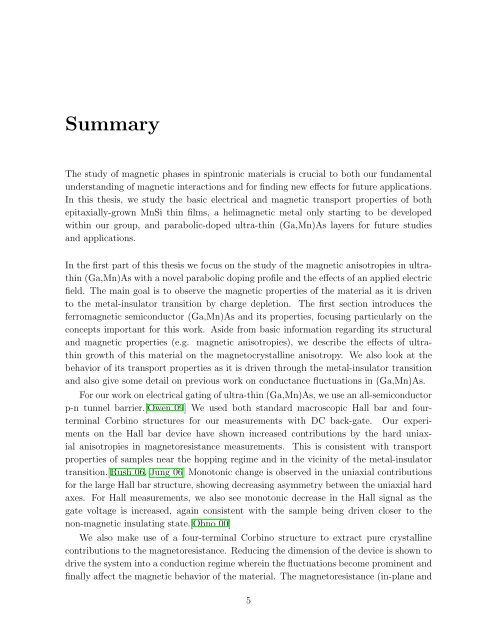As and Epitaxial-Growth MnSi Thin Films - OPUS Würzburg
As and Epitaxial-Growth MnSi Thin Films - OPUS Würzburg
As and Epitaxial-Growth MnSi Thin Films - OPUS Würzburg
You also want an ePaper? Increase the reach of your titles
YUMPU automatically turns print PDFs into web optimized ePapers that Google loves.
Summary<br />
The study of magnetic phases in spintronic materials is crucial to both our fundamental<br />
underst<strong>and</strong>ing of magnetic interactions <strong>and</strong> for finding new effects for future applications.<br />
In this thesis, we study the basic electrical <strong>and</strong> magnetic transport properties of both<br />
epitaxially-grown <strong>MnSi</strong> thin films, a helimagnetic metal only starting to be developed<br />
within our group, <strong>and</strong> parabolic-doped ultra-thin (Ga,Mn)<strong>As</strong> layers for future studies<br />
<strong>and</strong> applications.<br />
In the first part of this thesis we focus on the study of the magnetic anisotropies in ultrathin<br />
(Ga,Mn)<strong>As</strong> with a novel parabolic doping profile <strong>and</strong> the effects of an applied electric<br />
field. The main goal is to observe the magnetic properties of the material as it is driven<br />
to the metal-insulator transition by charge depletion. The first section introduces the<br />
ferromagnetic semiconductor (Ga,Mn)<strong>As</strong> <strong>and</strong> its properties, focusing particularly on the<br />
concepts important for this work. <strong>As</strong>ide from basic information regarding its structural<br />
<strong>and</strong> magnetic properties (e.g. magnetic anisotropies), we describe the effects of ultrathin<br />
growth of this material on the magnetocrystalline anisotropy. We also look at the<br />
behavior of its transport properties as it is driven through the metal-insulator transition<br />
<strong>and</strong> also give some detail on previous work on conductance fluctuations in (Ga,Mn)<strong>As</strong>.<br />
Forour workonelectrical gatingofultra-thin(Ga,Mn)<strong>As</strong>, we usean all-semiconductor<br />
p-n tunnel barrier.[Owen 09] We used both st<strong>and</strong>ard macroscopic Hall bar <strong>and</strong> fourterminal<br />
Corbino structures for our measurements with DC back-gate. Our experiments<br />
on the Hall bar device have shown increased contributions by the hard uniaxial<br />
anisotropies in magnetoresistance measurements. This is consistent with transport<br />
properties of samples near the hopping regime <strong>and</strong> in the vicinity of the metal-insulator<br />
transition.[Rush 06, Jung 06] Monotonic change is observed in the uniaxial contributions<br />
for the large Hall bar structure, showing decreasing asymmetry between the uniaxial hard<br />
axes. For Hall measurements, we also see monotonic decrease in the Hall signal as the<br />
gate voltage is increased, again consistent with the sample being driven closer to the<br />
non-magnetic insulating state.[Ohno 00]<br />
We also make use of a four-terminal Corbino structure to extract pure crystalline<br />
contributions to the magnetoresistance. Reducing the dimension of the device is shown to<br />
drive thesystem into a conduction regime wherein the fluctuations become prominent <strong>and</strong><br />
finally affect the magnetic behavior of the material. The magnetoresistance (in-plane <strong>and</strong><br />
5
















